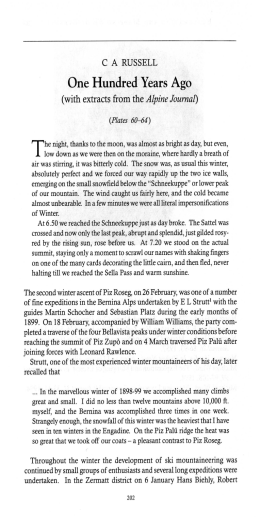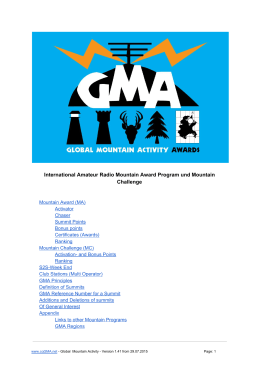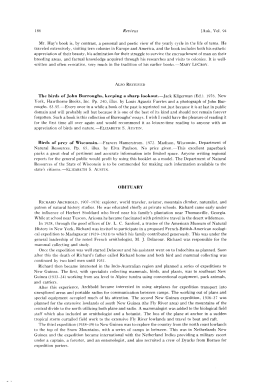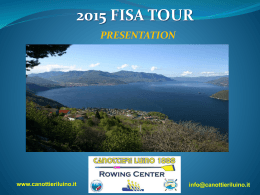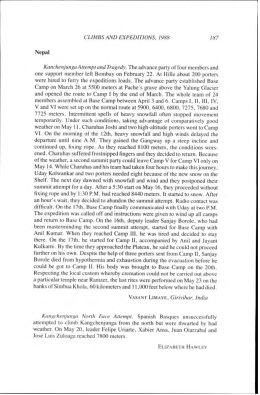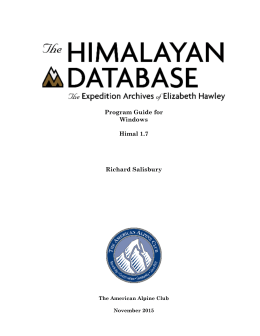JOSE LUIS BERMUDEZ Climbing on Kangchenjunga since 1955 T he history of climbing on Kangchenjunga in the years immediately after the first ascent is easily told. Nothing happened for almost twenty years. There were many reasons for this. The sheer remoteness of the mountain must surely be one, as must the political difficulties in getting permission to climb the mountain either from Sikkim or from Nepal. And it is understandable that in the late 1950s the attention of mountaineers should have been focused on the 8000-metre peaks that were still unclimbed. Kangchenjunga's status as a holy mountain was a further obstacle. So it is not entirely surprising that there were no expeditions to the Kangchenjunga massif between 1955 and 1973. When climbers did eventually return to Kangchenjunga they found obvious and formidable challenges. Kangchenjunga has four distinct summits over 8000m. 1 The 1955 expedition climbed the Main Peak, which is the highest at 8586m. But that still left three virgin summits which were not much shorter: the South Summit at 8476m, the Central Summit at 8482m and the West Summit (better known as Yalung Kang) at 8505m. Equally significant were the two routes that had been attempted on the Main Peak before the successful expedition. The route taken by the first ascensionists was the Yalung (SW) Face, approached from the Yalung glacier on the Nepalese side of the frontier ridge. As emerged very clearly in the Seminar, the Yalung Face was not the route favoured by most previous attempts on the mountain. The three expeditions in the late 1920s and early 1930s had thought that the North Ridge was the key to the mountain. Paul Bauer's two expeditions in 1929 and 1931 had attempted to gain the North Ridge via its East Spur from the Zemu glacier in Sikkim, while Professor G 0 Dyhrenfurth's International Expedition of 1930 had come from the Nepalese side and tried to reach the North Ridge via its NW face. 2 Both of these routes deserved further attention. It was Yalung Kang, Kangchenjunga's unclimbed West Summit, that first lured climbers back. A Japanese expedition from the Kyoto University Academic Alpine Club attempted the peak from the south in the 1973 premonsoon season. Takeo Matsuda and Yutaka Ageta reached the summit on 14 May, but neither survived the descent. After a bivouac at 8000m, only Takeo was able to continue, and he fell to his death after being hit by a rock. Two years later an Austro-German team managed to put nine out of their eleven members on the summit, by what became the normal route up the mountain, starting from the Yalung glacier and then following the British 1955 route as far the Great Shelf. 50 CLIMBING ON KANGCHENJUNGA SINCE 1955 51 The first expedition back to the Main Summit of Kangchenjunga came from the Sikkim side. An Indian army team led by Col Narinder Kumar managed to obtain permission to try the route that Paul Bauer's two expeditions from Munich had attempted: the East Spur of the North Ridge. 3 The Germans had suffered a legendary epic in 1929, when they were forced to retreat after being caught in a blizzard high on the spur. In 1931 they managed to get to the top of the spur but retreated because of windslab conditions on the face leading up to the North Ridge. The Indians were a large team, using oxygen, high-altitude porters and Sherpas from Nepal. They battled their way up the pinnacles and ice towers of the spur, taking 16 days to establish a route up the 300 vertical metres of ridge separating Camp 3 and Camp 4. The face that had forced the Germans back in 1931 was firm and safe, and the summit was reached by Major Prem Chand and Naik Nima Dorje Sherpa on 31 May, after a race against the oncoming monsoon. In the following year (1978) a Polish expedition led by Piotr Mlotecki attempted the still unclimbed South Summit. 4 Approaching from the Yalung glacier they followed the British route up to the Great Shelf and then climbed a broad gully leading up to the South Buttress. Eugeniusz Chrobak and Wojciech Wr6z reached the South Summit on 18 May. Three other members of the expedition also (illegally) climbed the 8482m Central Summit (unsuccessfully attempted at the same time by a Spanish expedition - also illegally), but this does not seem to have gained much recognition as an independent summit. This was right at the beginning of the Polish assault on the Himalaya and Karakoram, and only the third time that Poles had climbed above 8000m - a record that was not destined to last for very long. 5 So, by 1979 all Kangchenjunga's summits had been climbed, and the German route up the East Spur of the North Ridge completed. Of the obvious challenges mentioned earlier, this left only the approach to the North Ridge via the NW face and the North Col, attempted in 1930. It was by this route, of course, that Doug Scott, Peter Boardman and Joe Tasker reached the summit on 16 May. Their expedition, the first oxygen-free ascent of Kangchenjunga, is described elsewhere in this volume. 6 (Doug Scott's 'Kangchenjunga 1979', pp44-49.) The following year, 1980, saw what might have been the third ascent of Yalung Kang, when two members of a Mexican expedition, using oxygen, left for the summit from the highest camp on the Austro-German route, but were never heard of again. The N side of Kangchenjunga received more attention when a Japanese expedition visited the Kangchenjunga glacier. The route climbed by Doug Scott's party in 1979 avoids the formidable serac barriers and ice terraces of the NW face proper by climbing the steep ice and rock face at its extreme leftmost end - what is technically the W face of the North Col. They did this for a good reason. It was the collapse of one of the huge seracs on the NW face (the so-called Ice Building) that killed Chettan, a porter on the 1930 expedition. Nonetheless, the 1980 52 THE ALPINE JOURNAL 1996 Japanese expedition took the NW face direct, reaching the summit on 17 May. Their route went straight over the Ice Building. During the next couple of years all that happened were repeats of the established routes. German, Japanese, French and Italian expeditions succeeded on the 1955 route, while a Czech expedition climbed the 1980 Japanese route in 1981. * The next event of note came in 1982 when Reinhold Messner, Friedl Mutschlechner and Ang Dorje made an oxygen-free ascent from the north, by a variant on the Japanese route. They climbed in something close to Alpine style, with two camps and then two bivouacs. 1983 saw two solos of the mountain. Both Pierre Beghin and Georg Bachler climbed the 1955 route on the SW face without oxygen. Only Beghin, though, made a proper 'bottom-up' and completely unassisted solo ascent. On his second attempt Beghin went from Base Camp to the summit in three days. 7 His was the first successful ascent during the postmonsoon season. Bachler, in contrast, climbed solo only from Camp 4 and was supported by a four-man Austrian team. The topography of Kangchenjunga, with its several summits and enormous ridges, makes it an obvious target for traverses. The first attempt came in 1984 from a very large Japanese expedition, with 23 climbers and 28 high-altitude porters. They approached from the Yalung glacier and, after setting up camps within striking distance of the South, Central and Main Summits, attempted to traverse all four peaks from E to W. Two members of the party, Seishi Wada and Toichiro Mitani, climbed three of the four summits (South, Central and Main) between 18 and 20 May, but did not actually traverse the summit ridge itself. After traversing the ridge between the South and Central Summits with some difficulty they descended to the Great Shelf and traversed across to rejoin the 1955 route to the Main Summit. Also in 1984, but after the monsoon, a Polish expedition came to the Yalung glacier to attempt the unclimbed South Face of Yalung Kang. Without Sherpas or oxygen they succeeded in climbing the 1500m buttress of rock and ice up the middle of the face, with a pitch of UIAA grade V at 8000m. The summit was reached on 7 October by Tadeusz Karolczak and Wojciech Wroz. A winter attempt was made from the north in 1985 by Chris Chandler and Cherie Bremer-Kamp, assisted only by a Nepalese porter Manghal Singh Tamang. The attempt ended with Chandler's death on 15 January 1985 from pulmonary oedema. 8 During the pre-monsoon season of the same year a 14-member Slovene expedition arrived to try the first ascent of Yalung Kang from the north. They climbed a route originally pioneered by Hermann Warth on the NW face between the Japanese 1980 route and the British 1979 route, which took them to a snow couloir between Kangchenjunga and Yalung Kang. On the hardest part of the face they encountered difficulties of UIAA grade * Repeat ascents will not subsequently be mentioned unless they are particularly significant. eLI M BIN G 0 N K A N G C HEN J U N GAS 1NeE I 95 5 53 VI. From the couloir Tomo Cesen and Borut Bergant climbed Yalung Kang by its East Ridge. Cesen was the bnly one using oxygen. They reached the summit on 22 April, but Bergant fell to his death at 9pm that evening as the two men were preparing a rappel. Cesen cut a terrace in the ice and spent the night walking up and down to keep awake. This was the controversial Slovene's first Himalayan expedition, and it was a hard introduction. A year later another Polish team made a very significant breakthrough with the first winter ascent of Kangchenjunga. Jerzy Kukuczka and Krzysztof Wielicki summited on 11 January 1986. It was the fifth 8000metre summit to be climbed in winter - and Kukuczka's third. Sadly, Andrzej Czok died of pulmonary oedema after reaching Camp 4. In 1987 there was a disastrous Indian expedition to repeat the route up the East Spur of the North Ridge, climbed 10 years earlier by Col Kumar's expedition. The expedition, led by Major General Prem Lal Kukrety, had 62 members. The first summit team of Phu Dorje, Chorten Tsering and Phu Pu Butia are presumed to have reached the summit on 24 May, although none of them were seen again. A second team set out on 31 May. Chander Singh, Bhawan Singh and Subhas Limboo all reached the summit, but Chander Singh fell to his death on the descent. Another new line up the NW face was climbed in 1988 by the very experienced team of Peter Habeler, Carlos Buhler and Martin Zabaleta, who had to dig deep to get off the mountain in one piece. 9 They took what seems to be almost exactly the line proposed by Dyhrenfurth's 1930 expedition. 10 After reaching the summit in the early afternoon of 3 May the three men descended immediately, returning to their tent at 9pm. A metre of snow fell that night. The next day they fought their way down through the snow to reach the site of Camp 3, only to find that it had been swept away by avalanches. They continued descending the following day, down the windslab-covered North Ridge until they finally reached the fixed ropes leading down to Camp 2 on the NW face. But they didn't know that Camp 2 had been avalanched two days before, sweeping the Sherpas Ang Nima and Dawa Nuru 300m down the slope with broken ribs. It was now three days since they had eaten and the three climbers only just managed to make it down to the glacier before collapsing. Buhler described it as the 'most gruelling test of endurance any of them had faced', which is a sobering thought. The traverse of the four summits of Kangchenjunga finally fell in 1989 to the Soviets, who had developed long arduous traverses into an art form in the Caucasus, the Tien Shan and the Pamir. Like all Soviet mountaineering, both at home and abroad, the expedition was planned with military precision. II Three camps were set up on the 1955 route up to the Great Shelf, and then high camps were established within striking distance of all four summits. As acclimatisation, three of the four tops were climbed by 54 THE ALPINE JOURNAL 1996 new routes. The Main Summit was climbed via the col between the Main and Central Summits; the South Summit by a route to the right of the 1978 Polish route; and the Central Summit by a new route from Camp 3. The traverse proper was undertaken from opposite directions. Five climbers led by Sergei Bershov reached the summit of Yalung Kang on 30 April, while another five climbers led by Vasily Elagin climbed to the South Summit on 1 May. The two parties, seven of whom used oxygen for the whole traverse and three after the first day, met in the saddle between the South and Central Summits. The traverse was completed at both ends on 2 May, although without following the summit ridge the whole way. The Soviet traverse was a magnificent achievement in many ways, but by the late 1980s the major innovations in Himalayan mountaineering were coming from lightweight teams moving in more or less Alpine style. The Slovenian Kangchenjunga expedition of 1991 was a case in point. Although it was a fairly large expedition, it split up into independent teams who climbed a variety of routes between them. 12 The major achievement was a new route on Kangchenjunga> South climbed by Marko Prezelj and Andrej Stremfelj. They took the extremely logical, but long, SW ridge from the Yalung glacier, climbing over what previous expeditions had called the Great Buttress and the Hogsback to reach the Great Shelf. After a short traverse along the Great Shelf they reached a couloir leading back to the SW ridge and arrived at the summit on the fourth day. They descended the Polish route. One of the members of the 1991 Slovene expedition was the well-known Polish climber Wanda Rutkiewicz, although she did not get high on the mountain. Rutkiewicz returned to the peak the following year with one other Pole and four Mexicans to attempt the NW face. She left for the summit at 3.30am on 12 April with Carlos Carsolio. Carsolio soon left her behind and reached the summit at 5pm. Three hours later, as he was descending, he encountered Rutkiewicz bivouacked in a snow cave at about 8250m. She had no sleeping-bag, stove or food, but seemed in good spirits. Sadly she was never seen again, and is believed to have died in the snow cave. Rutkiewicz was 49 years old and had climbed eight of the 8000-metre peaks in a career that had established her as one of the leading high-altitude mountaineers of her generation. Wanda Rutkiewicz was not the only leading female mountaineer to lose her life on Kangchenjunga. The Slovenian expedition of 1991 had seen Marija Franter fall to her death from exhaustion on the 1955 route. In 1994, women's mountaineering suffered a double blow when a predominantly Byelorussian expedition attempted the SW face. First, the Russian climber Yekaterina Ivanovna, who had succeeded on Everest, Shisha Pangma and Manaslu, was killed in an avalanche; a fortnight later the leading Bulgarian female mountaineer Yordanka Dimitrova disappeared C L J M B J N G ON K A N G C HEN J U N GAS J N C E I 9 5 5 55 at about 8300m while climbing alone for the summit. The main summit of Kangchenjunga remains one of the very few 8000-metre peaks yet to receive a female ascent (although Yalung Kang was climbed by Laurence de la Ferriere in 1984). The sad deaths of Benoit Chamoux and Pierre Royer this summer confirm Kangchenjunga's status (with K.2) as the most challenging of the 8000metre peaks. Isolated from the main ridge of the Himalaya, Kangchenjunga receives more precipitation than any other of the 8000-metre peaks. It bears the full brunt of the monsoon. Nor does it have any easy routes. All of its faces are objectively dangerous and its ridges long and hard. Challenges remain, but they will not be easily won. Kangchenjunga is a mountaineers' mountain, and it will remain so. REFERENCES AND NOTES 2 3 4 6 7 8 9 The Kangchenjunga massif actually has five summits, as is suggested by its Tibetan name 'Five Treasures of Snow'. The fifth summit is Kangbachen (7902m), which was first climbed by a Polish expedition on 26 May 1974 (see K W Olech, 'The First Ascent of Kangbachen', AJ80, 29-36, 1975). I do not think that it is properly described as a summit of Kangchenjunga because it would be possible to make a logical complete traverse of the mountain without including it. For the record, the second ascent of Kangbachen was made by a Yugoslav expedition in the post-monsoon season of 1974. Paul Bauer, Himalayan Campaign: The Attack on Kangchenjunga. Basil Blackwell, Oxford, 1937. F S Smythe, The Kangchenjunga Adventure. Victor Gollancz, London, 1930. An account of the 1930 International Expedition. Col Narinder Kumar, Kangchenjunga: First Ascentfrom the NorthEast Spur. Vision Books, Delhi, and East-West Publications, London and the Hague, 1978. Marek Malatynski, 'Kangchenjunga South and Central 1978' inAJ85, 43-49,1980. Voytek Kurtyka, 'The Polish Syndrome' in Mountain Review 5, 36-47, Nov/Dec 1993. See also Joe Tasker, Savage Arena. Methuen, London, 1982, and Peter Boardman, Sacred Summits, Arrow, London, 1982. Pierre Beghin, 'Kangchenjunga Solo' in AAJ1984, 15-18. See Cherie Bremer-Kamp, Living on the Edge: The Winter Ascent of Kangchenjunga. David and Charles, London,.1987. A rather overwritten and misleadingly subtitled account of the expedition. Carlos Buhler, 'Kangchenjunga's North Face', in AAJ 1989,23-30. 56 10 II 12 THE ALPINE JOURNAL 1996 Compare the photograph on page 24 of the article cited in note 9 with that between pages 202 and 203 of F S Smythe, The Kangchenjunga Adventure. Eduard Myslovski, 'Kangchenjunga 1989', in AJ95, 24-28, 1990/91. Tone Skarja and Marko Prezelj, 'Slovene Kangchenjunga Expedition' in AAJ 1992, 1-9. ACKNOWLEDGEMENT I am grateful to Trevor Braham for his helpful comments on an earlier version of this article.
Scarica
